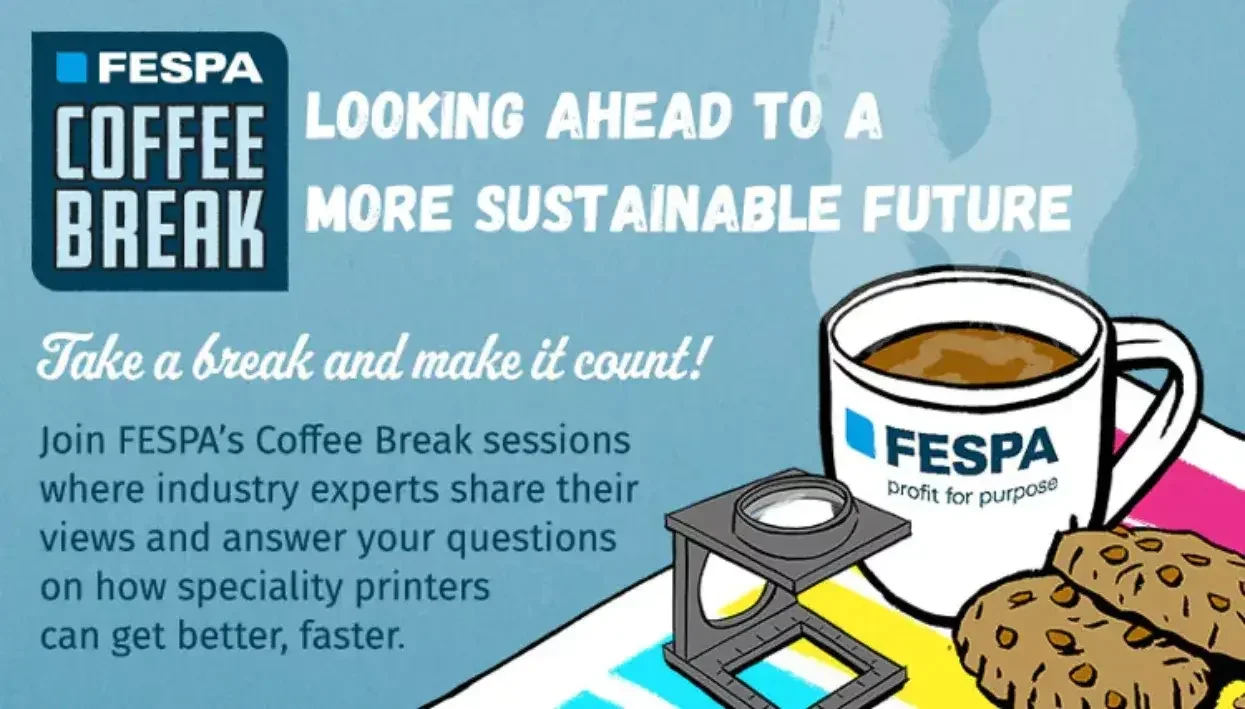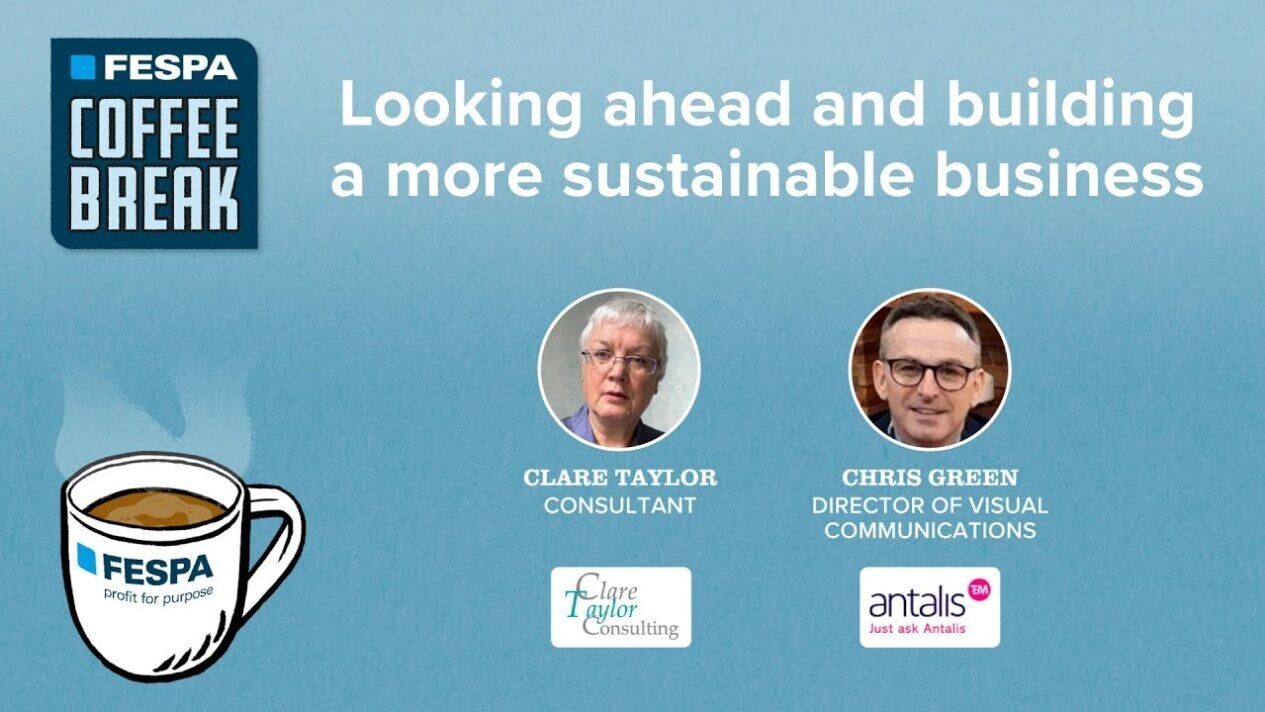
We brought together two people with expert insights into environmental issues to explore how a sustainability audit of your business will reveal opportunities to save energy, balance your carbon and attract new customers.
The host:
Graeme Richardson-Locke: Technical support manager, FESPA. With 35 years’ experience in the industry, Graeme began as an apprentice and progressed through several directorships before joining FESPA in his current role. He is also a member of the Academy of Screen and Digital Printing Technologies.
The experts:
Clare Taylor: Founder of Clare Taylor Consulting and independent consultant to the graphic arts industry. With a background working for design studios and ad agencies, Clare is also a former Head of Marketing Services at Cable and Wireless Communications where her role included carrying out environmental audits across Europe.
Chris Green: Director of Visual Communications, Antalis. Chris brings 25 years’ experience at the business to his current role which has a large focus on sustainability – looking at everything from product life cycles to future legislation in order to smooth the way for customers to make more sustainable choices.
…………………..
Graeme Richardson-Locke: The climate emergency represents the largest challenge we face on behalf of future generations. It’s clear that we all need to play our part to decarbonise our economies and hit net zero by 2050.
Currently, much of this activity is by voluntary agreement based around compelling international scientific evidence, and in the near future we’re likely to face more stringent legislative obligations to ensure carbon reduction and environmental protection. The industries that utilise specialty printing techniques may not be the worst offenders, but the need to move from a ‘take, make, waste’ approach to ‘reduce, reuse, recycle’ has to be our goal.
What business advantage can we gain by focusing our attention on sustainability?
Clare Taylor: A lot depends on what we mean by sustainability. Often people think it’s just the environment, but maybe with a social element. Actually it involves three pillars: people, planet, and prosperity. To my mind, a sustainable business is one that’s functioning well today, and which looks ahead. It’s prepared, it can sustain itself into the future and it protects its resources.
On the people side, if you’re looking after your staff well, they’ll perform well for you. If you’ve got a reputation as a good employer, it allows you to recruit from the best. If you’ve got good relationships with your customers and suppliers, if you look after them rather than simply doing business with them, and if you treat them well and fairly, it makes your relationship stronger.
On the environment side, a lot of what we need to do involves doing more with less. Using less energy and water and conserving resources. Saving waste saves money when it’s treated as a proper project. It’s not about cutting corners. It’s about finding better ways of doing things, thinking about whole systems rather than just points within them.
Most printers have a great deal of ingenuity and creativity. Harnessing this, using it to take a fresh look at how you’re working and what materials and equipment you’re using can be a very good trigger for change. One thing I hear so often is how difficult it is to keep up with the latest headline issue, whether it’s recycling or carbon footprint or plastics.
If you really understand how your business interacts with the environment, you’ll already be prepared for any issue that’s likely to directly affect you and you’ll have taken a decision on whether it’s something you need to address. You won’t be caught on the backfoot but instead can be a leader.
Onto prosperity. Quite apart from the savings made, customers do care about the environmental performance of their suppliers. Any organisation that has ISO 14001 has to consider the impacts of goods and services they purchase, and that trickles down the supply chain. Larger companies also have to report publicly on their environmental aspects. The more you can help your customers achieve their aims, rather than just printing for them, the more you’ll be valued. They do differentiate according to environmental management far more often than people often realise, it’s just not always visible.
Although business will often be won or lost on price, environmental considerations will usually have been involved in selecting a final shortlist.
Running a sustainable business does pay you long-term on all three fronts.
Chris Green: Within Antalis we’ve dedicated a large portion of our time towards how we can affect sustainability. Some of the international certificates we’ve got, such ISO 14001, demonstrate this. It’s all about those small improvements. Not trying to have a one ‘silver bullet’ approach to things, but taking a wide approach, one step at a time.
Graeme: Who should be responsible for the internal process of auditing a print business?
Clare: I think we’ve got two levels here. First, there’s overall responsibility, which sits with senior management. If they’re not showing leadership, this can’t work. Staff need to know that it’s serious. Whoever it is who takes this on day-to-day, they need to be fully backed up by management and given all the resources they need. that means training to be effective, the time to do it – whatever is needed to make it work.
On a day-to-day basis, it needs to rest with someone with enough knowledge of the business that they know what questions to ask and where to look. This can sometimes mean a team that has different areas of knowledge. Ideally, no-one should audit their own work because that’s really hard to do, you’re too close to it.
And whoever carries out auditing, as well as technical abilities, needs certain personality traits. They need to be curious and not afraid of asking questions. You’re looking for opportunities to improve, which means getting ideas from people who are close to the process. They need to be objective and non-judgmental, because an audit isn’t to find fault, it’s to find out why things aren’t working, to know what you can do to correct it, and to put something in place to stop it from happening again.
People are usually trying to do their best and when things go wrong, it tends to be because they didn’t have enough training, they don’t have enough knowledge, they don’t have the right equipment, or they’re working under pressure and don’t have enough time. All of which can be changed once you know about it. One of the main things is feeling comfortable with asking “why?” a lot. Even though this can often really annoy people! Never assume anything – always ask “why?”.
Chris: Within our business, we’ve got a specific person who is really passionate in this area, and very inquisitive. He knows all the detail on all the international standards and all the processes that we need to be aware of as a business. Understanding our business is important as well, where we are today and where we want to get to.
Graeme: What initiatives have Antalis undertaken to help with carbon balancing?
Chris: Carbon balancing has been a feature of our company for a number of years now, but as of the beginning of this year, it’s available across the entire Antalis range. This is important because the amount of carbon that goes into some of our manufacturing processes, polymeric products for example, and even some of our papers, is quite high.
Our carbon offset system allows customers to capture that and then offset it through approved schemes. At Antalis we want to really clear in saying, “There are some choices to be made.” And we’re giving people the opportunity to do that via carbon offsetting whether it be a paper product, a visual communications item, or a packaging material.
For our customers we also offer a carbon offsetting footprint tool, which allows them to audit their own business and understand what they themselves can do in terms of sustainability.
We’re working with our suppliers to give us solutions to some of the more problematic application areas. Take a product like PVC: it’s a really good product, it’s generally priced attractively, and it’s extremely well suited to a number of applications, particularly outdoors. But it’s clear that PVC is difficult to dispose of at the end of its life. What can you do in a situation like that? In some cases, you can choose something else that’s recyclable. If it has to be PVC, this is where the carbon offsetting scheme comes in. We’re trying to give people the tools to make informed choices around sustainability issues, and having dialogue with our customers and our suppliers to make sure that the right product selection is in place.
Graeme: Currently, the industry is in survival mode. Customers prefer sustainable products but don’t want to or can’t pay extra. How can we start getting past this problem?
Chris: We’re further down the line on sustainability in terms of product selection than many may think, but sustainable alternatives aren’t always readily available and I understand the argument of those who say they want to be sustainable but can’t afford to be. I do think though, that the legislative side of things is not going to go away and the cost of some of these less sustainable products will increase. There will be a tipping point.
Clare: I think it’s also important to start at the design end. If a customer genuinely does want something that’s more sustainable, look at its purpose and see if you can design it to be more sustainable. For example, if you’re doing a banner for a school stage and it’s going to be outside for two weeks, you don’t want it to be made of paper if it’s in Manchester, but you might get away with it if you’re in Arizona. You look at the purpose and design to make it as sustainable as possible. But of course, the customer has to buy into the proposed design.
Within your own factory, being more efficient will generally make you more sustainable without adding extra cost.
Graeme: Thank you Clare and Chris for your insight.

